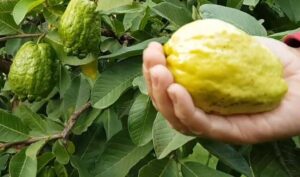In this article, we are going to focus on providing you information about the guava fruit tree, taste, juice, and benefits.
Guava Fruit Tree
Guava fruit is a fruit of a common tropical guava plant that is widely cultivated in various tropical and subtropical countries.
The plant from which guava fruits are produced is scientifically known as Psidium guajava and is belong to the family Myrtaceae.
The fruit is believed to be the native of the Caribbean, Mexico, and Central America. But currently, the fruits can be found in almost all sunshine countries.
Flower Formation and Availability
The Guava fruit tree is well adapted to tropical and subtropical climates. However, guava fruit trees can also thrive in many types of soils and include clay and light sand to Merl kind limestone soils.
The ideal temperature of the guava fruit tree range from 73 to 82°F. If the temperature goes below 60°F, guava fruit plant growth may tamper negatively.
However, the mature plant of guava can withstand short cold swaps with negligible damage. And young guava plants may be destroyed by temperatures 28°F.
While guava fruit trees can bloom year-round in low climates, spring is the main season where fruits are available.
The fruits are usually ready 90 to 150 days after first bloom, normally in the late summer or early fall, which depends on where the guava tree is growing.
During ripening, the fruits usually change color from green to golden yellow and become very soft when fully mature.
The flowers of guava fruit trees are mainly pollinated by honeybees.
Types And Varieties
There are different varieties of guava, which are grown throughout Mexico, India, Southeast Asia, and the United States.
Each variety of the guavas possesses its own unique taste, color, and size.
The 2 most common and earliest American-grown guava fruit varieties were Detailed and the Redland.
The Detwiler is originated in Riverside CA in the early 1900s. It was about 3 inches. The fruit is covered with green-yellow skin, a salmon-colored finer flesh, and a sweet fragrant flavor.
While the Redland was originated in 1941 at the University of Florida in Homestead. It was Florida’s first guava variety.
However, the variety was soon left due to its mild fragrant taste and susceptibility to algal spotting.
Other varieties that are currently in use are Mexican cream, Red Indian, Hong Kong pink, White Arabian, Ruby X supreme, and Barbi pink.
Guava Fruits Pictures
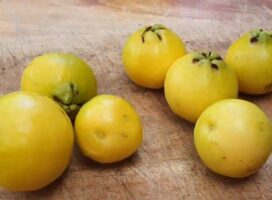
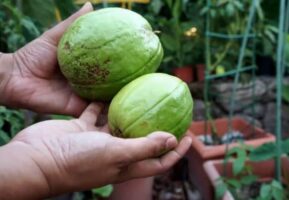
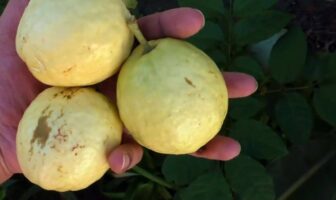

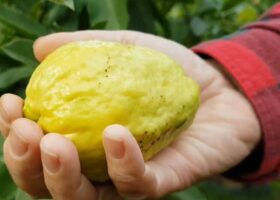
Guava Fruits, Taste, Size, and Color
Guava fruits grow on a multitrunked or a single plants and can reach an approximate height of up to 20 feet.
The guava fruit tree is similar to that of apples and pears. The fruits are usually round or oval in shape and some are about 1-3cm in diameter.
The color of guava fruit skin range from green, slightly pink, red, or yellow.
The fruits have small hard seeds. However, some varieties possess soft seeds.
The flesh or pulp also range in color from creamy white, golden yellow, red, pink, to white.
Some fruits have a fragrant aroma and sweet taste. However, some varieties are sour or slightly tart.
Moreover, depending on the variety, the pulp may be firm or soft and with numerous seeds that perforated the flesh.
Nutrition Facts Of Guava Fruit
The fruits of guava are rich in many nutrients which include minerals, vitamins, antioxidants, and soluble fibers.
The fruits of the guava tree also contain healthy carbohydrates, proteins, fatty acids, and water.
Learn more about the nutritional value of guava fruits:
>Minerals And Vitamins In Guava Fruits And Leaves
>List Of Antioxidants In Guava Leaves And Fruits
>Nutrition Facts Of Guava And Health Benefits
Guava Fruit Juice
The fruit of guava can be procced into juice either alone or in combination with other fruits like apples, pineapple, and pawpaw.
The guava fruits juice can also be made with milk and flavor it with honey.
The juice is an important component in the diets of many people in tropical and subtropical countries.
Common Diseases Of Guava Fruits
Common diseases of guava fruits include algal spot and anthracnose.
Learn more about the diseases of guava fruit tree here
Common Pest of Guava Fruits
Common pests of guava fruits include fruit fly, aphids, nematodes, and thrips.
Learn more about the pests of guava fruits tree here
Harvesting and Storage
Usually guava is harvested by hand.
However, some farmers do prefer to use mechanical tree nets and Shakers. The harvesting is done base on where the fruits are going to be transported or when the fruits are going to be used.
Those that are less ripe and full-sized with dark to light green can be harvested for long-term use and transportation.
While those that are fully ripe and soft are usually hand-picked for short term use or transportation.
In all cases, both ripe and unripe green guava fruit can be stored for up to 5 or 7 days before consumption.
The normal storage temperature of guava fruit is between 46 and 50°F for mature green guava and fully ripe guava fruits require 41 to 46°F with 90-95% relative humidity.
Guava Fruits Benefits
- Guava fruits have phytochemicals effective for reducing body swelling and redness
- Guava fruits are also eaten fresh as an immediate of energy
- The fruits contain high amount of fiber, which helps cleanse digestive tract and improve bowel movement
- The fruits are also good in the management of piles
- The fruits can also help glucose metabolism and useful for the treatment of diabetes
- The fruits without the peels contain calories, which can be effective for weight loss management
- The fruits, which is slightly ripe or those with sour taste contain high amount of Vitamins, which is useful for controlling heart diseases
- The fruits are also shown to regulate hormone production and imbalance
- The fruits are also used in the control of desyntery and diarrhoea
Conclusion
In this post, we covered almost everything about a guava fruit tree, taste, varieties, juice, and benefits. We also went ahead to discuss the common pests and diseases of guava fruits.
We hope that the guide will help you in understanding the morphology, taste, color, size, and benefits of guava fruits.
We would love to hear your questions and views about this post. So, let us know your questions in the comment section below.
Recommended reading:
>Health Benefits Of Guava Leaves For Inflammation
>Guava Leaves For Kidney Problems: Is There Any Health Benefits?
>Health Benefits Of Guava Leaves For Prickly Heat
>How To Use Guava Leaves For Pimples
>Guava Leaves For Prostate Cancer: Find Out The Health Benefits
>Guava Leaf Tea: The Detailed Guide To Preparation, Uses, And Side Effects
References
Akanda, Md. Khokon & Mehjabin, Sanzia & Uzzaman, Shakib & Parvez, Masud. (2018). A short review of a Nutritional Fruit: Guava. Toxicology Research. 1. 1-8. https://www.researchgate.net/publication/330702066_A_short_review_on_a_Nutritional_Fruit_Guava
Daswani PG, Gholkar MS, Birdi TJ. Psidium guajava: A Single Plant for Multiple Health Problems of Rural Indian Population. Pharmacogn Rev. 2017;11(22):167-174. doi:10.4103/phrev.phrev_17_17 https://www.ncbi.nlm.nih.gov/pmc/articles/PMC5628524/
König A, Schwarzinger B, Stadlbauer V, et al. Guava (Psidium guajava) Fruit Extract Prepared by Supercritical CO2 Extraction Inhibits Intestinal Glucose Resorption in a Double-Blind, Randomized Clinical Study. Nutrients. 2019;11(7):1512. Published 2019 Jul 3. doi:10.3390/nu11071512 https://www.ncbi.nlm.nih.gov/pmc/articles/PMC6683095/
Kumari, Suchitra & Devi, R. & Mangaraj, Manaswini. (2016). Effect of Guava in Blood Glucose and Lipid Profile in Healthy Human Subjects: A Randomized Controlled Study. Journal of Clinical and Diagnostic Research : JCDR. 10. BC04-BC07. 10.7860/JCDR/2016/21291.8425. https://www.researchgate.net/publication/308222955_Effect_of_Guava_in_Blood_Glucose_and_Lipid_Profile_in_Healthy_Human_Subjects_A_Randomized_Controlled_Study
Shen, Szu-Chuan & Cheng, Fang-Chi & Wu, Ning-Jung. (2008). Effect of Guava (Psidium guajava Linn.) Leaf Soluble Solids on Glucose Metabolism in Type 2 Diabetic Rats. Phytotherapy research : PTR. 22. 1458-64. 10.1002/ptr.2476. https://www.researchgate.net/publication/23282081_Effect_of_Guava_Psidium_guajava_Linn_Leaf_Soluble_Solids_on_Glucose_Metabolism_in_Type_2_Diabetic_Rats
Tiwari, Anupam & Pal, A.K. & Singh, S.P. & Jain, Vikas & Pal, Sumit. (2017). Varietal Influence on Post-harvest Weight Loss and Biochemical Changes under Ambient Storage of Guava Fruits. Indian Journal of Ecology. 44. 848-851. https://www.researchgate.net/publication/322330664_Varietal_Influence_on_Post-harvest_Weight_Loss_and_Biochemical_Changes_under_Ambient_Storage_of_Guava_Fruits
Sharma P. Vitamin C rich fruits can prevent heart disease. Indian J Clin Biochem. 2013;28(3):213-214. doi:10.1007/s12291-013-0351-y https://www.ncbi.nlm.nih.gov/pmc/articles/PMC3689326/
Verma AK, Rajkumar V, Banerjee R, Biswas S, Das AK. Guava (Psidium guajava L.) Powder as an Antioxidant Dietary Fibre in Sheep Meat Nuggets. Asian-Australas J Anim Sci. 2013;26(6):886-895. doi:10.5713/ajas.2012.12671 https://www.ncbi.nlm.nih.gov/pmc/articles/PMC4093245/
Ram B. Singh, Shanti S. Rastogi, Reema Singh, Saraswati Ghosh, Mohammad A. Niaz,Effects of guava intake on serum total and high-density lipoprotein cholesterollevels and on systemic blood pressure. The American Journal of Cardiology,Volume 70, Issue 15,1992, Pages 1287-1291, ISSN 0002-9149,
(http://www.sciencedirect.com/science/article/pii/000291499290763O)
Kumari S, Rakavi R, Mangaraj M. Effect of Guava in Blood Glucose and Lipid Profile in Healthy Human Subjects: A Randomized Controlled Study. J Clin Diagn Res. 2016;10(9):BC04-BC07. doi:10.7860/JCDR/2016/21291.8425 https://www.ncbi.nlm.nih.gov/pmc/articles/PMC5071920/



